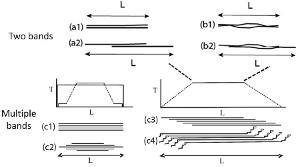| |||||||
|
|
|||||||
|
|
|||||||
| Mechanisms and Mechanics of Compaction Band Zones | |||||||
|
There are two mechanisms for the formation of the compaction band zones. First, sequential formation of two or more bands adjacent to each other. Second, the interaction among bands nearby. Please see 'Compaction Band Zones' and 'Echelon Volumetric Bands.' Figure 1 includes a number of conceptual models depicting how compaction bands are added sequentially to form zones. The total thickness of the zone depends on the architecture of the zone. Sub-parallel bands of equal length (a1 and c1) may be defined by a nearly constant thickness, while sub-parallel bands of different lengths (a2, c2, and c3) may have variable lengths. Field measurements by Torabi et al. (2015) indicate that along most of the zone length (L), except eye structures, the thickness (T) remains almost constant. This arrangement also results in splays of various geometry distributed along the whole zone. | |||||||
| Reference: |
|||||||
| Torabi, A., Aydin, A., Cilona, A., Jarsto, B.E., Deng, S., 2015 |
|||||||
|
Readme | About Us | Acknowledgement | How to Cite | Terms of Use | Ⓒ Rock Fracture Knowledgebase |
|||||||
